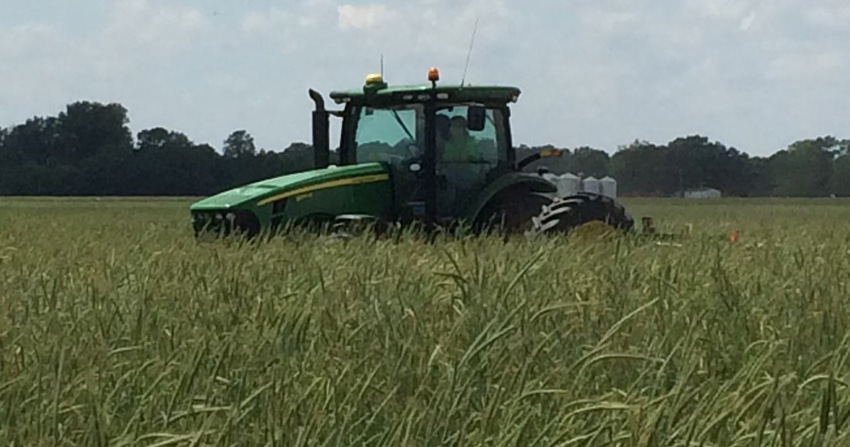
Steve Stevens is one of the large growers looking for methods to reduce water consumption, costly nutrients or chemicals, and fuel as inflation rises. Irrigation efficiency is making a large contribution to his bottom line.
Stevens farms on 4,800 acres in Tillar, Ark., and utilizes irrigation system models and data to steer his operation in a positive direction for years to come.
Irrigation modeling
While Stevens was attending a crop management meeting in Little Rock Arkansas in 2008, he was approached about a new computer program that would reduce pumping time by 40%.
“I was in disbelief,” he said. “Phil Tacker challenged me to try it on six fields and if it didn’t work then no harm done.”
Stevens agreed and quickly realized the benefits.
“Phil Tacker agreed to help set up the first couple of fields and prove it worked,” he said. “After seeing the first two fields get irrigated more evenly and it took 40% less time pumping, I decided the whole farm must go on the PHAUCET program as fuel was approaching $4 per gallon, similar to this year.”
The next two weeks were spent gathering data from all over the farm to accurately model the irrigation systems. The data required included the flow off each well, all the turn row elevations, and row lengths.
With fuel prices high, gathering this data was a top priority. Stevens continued working 18-hour days while gathering data on 155 fields and 450 sets.
Utilizing the PHAUCET program, the modeled irrigation system proved to be effective and worthwhile.
“We were able to save $100,000 in fuel costs in the first year, reducing engine/well repair costs, and most of all save 40% of the groundwater used,” he said.
While the savings in fuel and water quickly added up, Stevens’ curiosity about data never ended.
Field monitoring
In 2011, Stevens was approached about enrolling his cotton and corn farm in the Discovery Farm Program with the University of Arkansas, which monitors water runoff for phosphate and nitrogen.
“These are the two nutrients charged with causing the dead zone in the Gulf of Mexico,” he said.
The Arkansas Discovery Farms Program conducts research to proactively address the needs of farmers. There are currently 12 farms enrolled throughout the state.
The program runs five to seven years. During that time, water samples are collected and analyzed to evaluate the effectiveness of conservation practices being utilized on the farm.
Research is coordinated by the University of Arkansas-Division of Agriculture, with the collaboration of federal and state agencies promoting the conservation of natural resources.
Once Stevens agreed to enroll part of his farm in the program, monitoring equipment was quickly installed. The equipment installed in the first year included runoff water quality and collection stations.
The next stage involved soil moisture sensors at six, 12, and 18-inch depths in multiple locations throughout the fields.
“The first year with PHAUCET computerized hole selection, we learned our irrigation efficiency was running in the 90% range,” he said. “We had very low nutrient runoff from irrigation, and our soil moisture sensors did not pick up irrigation water, as we had poor soil health not moving water thru the soil profile.”
Making changes
Later Stevens visited Bill Robertson, a cotton extension agronomist with the University of Arkansas, on how to resolve the issue of water not moving down into the soil profile.
“Robertson first suggested deep tillage and I told him that we have been there and done that,” he said. “It does not last very long and can cause problems getting planted or harvested with high rainfall events.”
After further discussion, Robertson suggested a cover crop using cereal rye. Stevens agreed to give it a try by starting with 50 acres that fall. He began by planting 60 lbs. per acre, flying by plane before the leaves could drop.
“This was a huge success,” he said. “Roots extended down up to 18 inches from the cover crop as well as roots from the cotton went from 6 inches deep to approximately 15 to 18-inches deep.”
This meant the cottonseed roots could tap into the nutrients available in previously unused soil.
“Water intake doubled after adding the cover crop and was now soaking from middle to middle,” he said. “Soil sensors began showing irrigation events or often, more rainfall stayed in the field, and we could go extended periods of time before irrigation was needed.”
Stevens has had Discovery Farm monitoring in place for nine years. He plants half a field farmer standard or stale seedbed and the other half as no-till and cover crop, trying different practices and looking for better more efficient methods to reduce costs per lb. growing cotton.
“Over a five-year period, the average cost of growing cotton is five cents per lb. less on the no-till cover crop as compared to stale seedbed (farmer standard),” he said.
Discoveries
Stevens has gone from 50% efficiency to 90% efficiency on irrigation using computer hole selection, first with PHAUCET and now with Pipe Planner.
He learned by using a cover crop, he can capture more rainfall while reducing the amount of groundwater needed for the crop. That saves both groundwater and irrigation costs.
He also discovered that pumping extra time after a set gets out, thinking it will soak more into the soil, is a waste of fuel and water as 99% of the soak water runs out of the field. This was verified by the monitoring units used on his Discovery Farm.
About the Author(s)
You May Also Like




